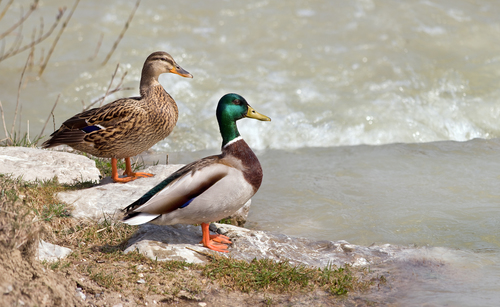
Mallard
The Mallard (*Anas platyrhynchos*) is arguably the most recognizable duck in the world, and is the ancestor of almost all domestic duck breeds. Found throughout the Northern Hemisphere and introduced to various parts of the Southern Hemisphere, it's a highly adaptable species, thriving in a wide variety of wetland habitats. Ecologically, Mallards play a role in seed dispersal and nutrient cycling, and are a food source for various predators. Culturally, they are a familiar sight in parks and ponds, often depicted in art and folklore, and are a popular game bird.
50-65 cm
Length
81-98 cm
Wingspan
Least Concern
Conservation Status
Distribution
Native to North America, Europe, Asia, and North Africa. Introduced to Australia, New Zealand, South America, and South Africa. Migratory in northern parts of its range, moving south for the winter. Altitudinal range varies from sea level to high-altitude lakes.
Lifespan
Typically 3-5 years in the wild, but can live up to 10 years or more. Captive individuals can live longer.
Mallard's Habitat
Habitat Types
Wetlands, Lakes, Ponds, Rivers, Marshes, Estuaries, Coastal waters, Urban parks
Climate Zones
Temperate, Subtropical, Tropical, Boreal
Adaptations
Mallards are highly adaptable to different water salinities, thriving in both freshwater and brackish environments. They can tolerate a wide range of temperatures, from freezing conditions in winter to hot summers.
Variations
Several subspecies have been proposed, but their validity is often debated. There are slight variations in size and plumage color across their range. Introduced populations may show characteristics differing from their ancestral stock.
Appearance
Breeding Plumage
Males (drakes) in breeding plumage have an iridescent green head, a white neck ring, a chestnut-brown breast, and gray body. Females (hens) are mottled brown year-round. After breeding, drakes molt into an 'eclipse' plumage, resembling females.
Seasonal Feather Changes
Males undergo a complete molt after breeding, losing their bright colors. They regain breeding plumage in the fall.
Sex Based Plumage Differences
Highly pronounced, with males having distinctive breeding plumage.
Notable Features
Iridescent green head (breeding male), White neck ring (breeding male), Blue speculum (wing patch) bordered with white, visible in both sexes, Curled black upper tail coverts (male)
Diet and Feeding
Primary Foods
Seeds, Aquatic plants, Insects, Crustaceans, Mollusks, Grain
Foraging Behavior
Mallards are dabbling ducks, feeding by tipping their bodies forward in the water to reach submerged vegetation and invertebrates. They also graze on land.
Specializations
Their lamellae (comb-like structures on the bill) help filter small food items from the water.
Seasonal Diet Variations
Diet varies with food availability. During breeding season, they consume more protein-rich invertebrates. In winter, they rely more on seeds and grains.
Behavior
Social Structure
Mallards are highly social, especially outside the breeding season, forming large flocks. During breeding, they form pairs, but males may pursue extra-pair copulations.
Communication
Quacking (primarily by females), Whistles, Grunts, Visual displays (head-bobbing, wing-flapping)
Migration
Many populations are migratory, flying long distances between breeding and wintering grounds. Migration is triggered by day length and weather conditions. They often migrate in large flocks, following established flyways.
Territorial or Group Behaviors
Males defend a small territory around the female during the early breeding season, but this defense is not as strong as in some other duck species. Large flocks are common outside of breeding.
Conservation
Threats
Habitat loss and degradation (wetland drainage), Hunting (in some regions), Lead poisoning (from ingestion of spent lead shot), Hybridization with domestic ducks
Protection Programs
Wetland conservation and restoration initiatives, Hunting regulations, Bans on lead shot in some areas, International agreements like the Ramsar Convention on Wetlands
Local National Laws
Protected under various national and international wildlife laws, such as the Migratory Bird Treaty Act in the United States and Canada.
Population Trend
Stable
Population Estimates
Estimated global population of 19-27 million individuals (Wetlands International).
Interesting Facts
Mallards are the ancestors of almost all domestic duck breeds.
Except for the Muscovy Duck, all domestic ducks are descended from Mallards.
Mallards can hybridize with other duck species.
This can lead to fertile offspring and sometimes poses a conservation concern for rarer duck species.
Mallards can fly at speeds up to 65 mph (105 km/h).
They are strong fliers, capable of long-distance migrations.
Mallards sleep with one eye open and half of their brain active.
This allows them to stay alert for predators while resting. This is called unihemispheric slow-wave sleep.
Faqs about Mallard
What is the difference between a male and female Mallard?
Male Mallards (drakes) have a bright green head, white neck ring, and chestnut breast during breeding season. Females (hens) are mottled brown year-round.
Do Mallards mate for life?
Mallards form seasonal pair bonds, meaning they typically choose a new mate each breeding season.
What should I feed Mallards at the park?
It's best not to feed Mallards, as bread and other human foods can be unhealthy for them. If you must feed them, offer small amounts of birdseed, corn, or chopped vegetables.
Why are some Mallards white?
White Mallards are usually domestic ducks that have escaped or been released, or they may be hybrids between Mallards and domestic ducks.
Copyright @ Nature Style Limited. All Rights Reserved.
 English
English